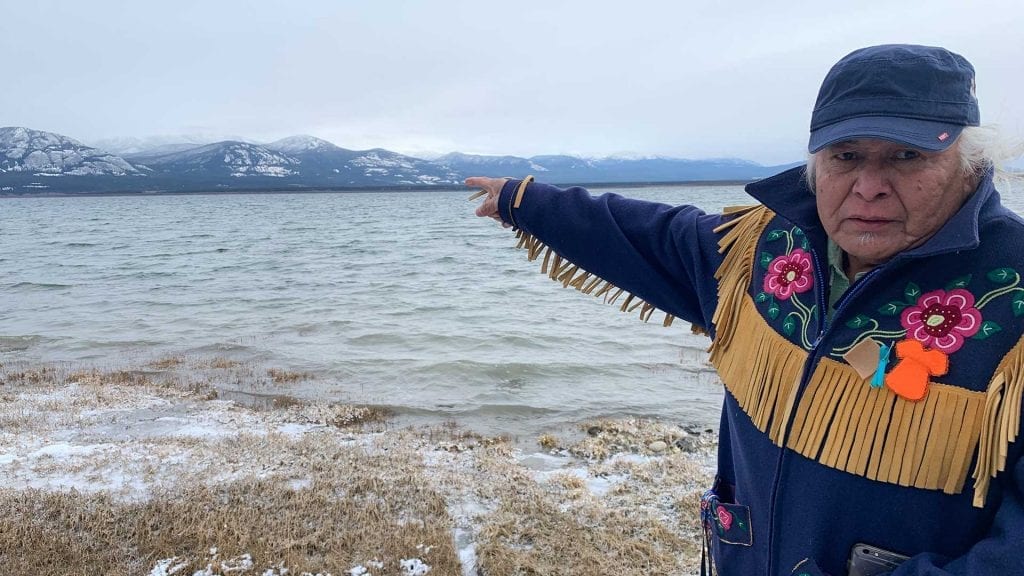
Joe Copper Jack points to the area his grandfather Chief Jim Boss took his people to wait out a flu outbreak. Photo: Sara Connors/APTN.
In 1914 Jack Copper’s grandfather Kishwoot, more commonly known as Chief Jim Boss, took his people into the bush outside of Whitehorse to get away from an outbreak of the flu.
It’s a story Jack still remembers from childhood.
Now he’s hoping lessons learned from traditional teachings and history can be used to fight the diseases and environmental issues of today, including the COVID-19 pandemic.
A member of Ta’an Kwäch’än Council, Copper is a proponent of One Health.
One Health is an approach based on the idea that the health of the people is tied to the health of the land.
For instance, illness seen in animals, like rabies, ringworm and West Nile virus, can sometimes act as a warning sign of human illness.
According to the U.S. Centers for Disease Control and Prevention (CDC) “birds often die of West Nile virus before people in the same area get sick with West Nile virus infection.”
The aim of One Health is to implement collaborative strategies between multiple sectors; like health care, zoology, environmentalism and First Nations interest groups; to fight disease, poor health and environmental destruction.
Jack said One Health echoes First Nations principles and teachings, in that patterns and experiences of the past can be used as preventative measures for the future.
“The land, health, animal health and human health have to be treated as one, which basically follows the same principle of First Nations laws of interconnectedness,” Jack said.
One Health proponents like Jack say collaboration involving multiple sectors is key to solving health and environmental issues, and organizations are starting to take note.
Australia recently committed $650 million for Indigenous rangers to use traditional law to take care of the land, plant and animals, and the CDC uses the One Health approach by involving experts in human, animal, environmental health in monitoring disease control.
Copper said Yukon’s wildfire department is also now looking at implementing a First Nations’ collaborative model he designed based on One Health principles.
“They’re interested in us designing a program that mixes strongly with (Ta’an Kwäch’än) laws and principles that they can share with their firefighters, and to develop a program that would turn firefighters into land protectors.”
Last month, Jack and three other Yukon authors had a letter published in the prestigious scientific journal Science, advocating for a One Health approach to the pandemic by incorporating Indigenous knowledge principles.
Co-author and Taku River Tlingit member Jared Gonet is board president of the Yukon Conservation Society.
He’s using One Health in his own PhD research on conservation and biocultural indicators, like how animals need to be included in decision making.
“On the Conservation Board Society we’re working to achieve a chair for the voiceless. So, if we’re sitting around and talking about grizzly bears, there would be a metaphorical chair for grizzly bears at the table, and we’d try to consider what that decision means for grizzly bears,” he said,” Gonet said.
“When you’re in a place, you need to consider the place you’re in.”
Gonet said if voices of the voiceless, like nature, animals and First Nations, were included in mainstream decisions, COVID-19 may have been prevented.
“There’s so many ecosystems around the world and they’re all just not respected,” said Gonet. “They’re there for the use of humans and humans alone, and we don’t really consider all the creatures and all the species that are on that land and how they deserve part of this world too.”
Gonet said more consultation with the natural world and Indigenous knowledge is needed in major decision making within communities, and hopes to see more funding in Indigenous environmental stewardship.
“That just brings traditional knowledge management into the whole parks or conservation area of planning, and how we interact with the land.”
And for Joe Copper Jack, history of the past, like the story of his grandfather, can be useful in today’s pandemic world.
“It may be a solution that could be applicable again during these pandemic times. First Nations or Indigenous peoples should have in mind certain areas that they wish to have protected to be used for this purpose,” he said.
“We have to be prepared now, to be prepared when it happens.”









